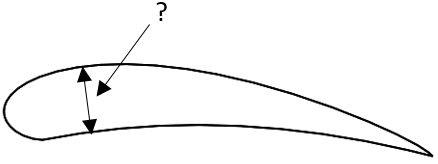This set of Aircraft Design Problems focuses on “Airfoil Selection-2”.
1. If an airfoil is operating at Mach 1.1, then it is working in _____
a) transonic range
b) supersonic range
c) subsonic range
d) hypersonic range
View Answer
Explanation: Based on mach number flow can be subsonic, supersonic, transonic or hypersonic. If flow mach number is <0.8 then it is subsonic. If flow mach number is >0.8 but <1.2 then, it is transonic. If flow mach number is in the range of 1.2-5.0 then, it is supersonic. If flow mach number is <5.0 then, it is hypersonic.
2. Which of the following is not an application of an airfoil?
a) To provide thrust for acceleration
b) To provide lift
c) To provide lift co-efficient
d) To provide streamlined flow
View Answer
Explanation: In an aircraft, engines are used to provide thrust for acceleration. Airfoil is used to provide lift, to improve certain flow characteristics. Streamlined flow is also produced by an airfoil.
3. What is represented by ‘?’ in following diagram of an airfoil?

a) Thickness
b) Chord
c) Leading edge
d) Trailing edge
View Answer
Explanation: Thickness is distance between upper and lower surface of the airfoil. Leading and trailing edge are foremost and most rear parts of airfoil. Thickness will be different at each section of an airfoil.
4. From following diagram body-1 is not streamline?

a) True
b) False
View Answer
Explanation: Body-1 is typical airfoil shape. An airfoil is streamline body. Body-2 is not a streamline body as compare to body-1. Streamline body will provide streamline flow.
5. NACA stands for _____
a) National Advisory Committee for Aeronautics
b) National Authorized Committee for Aeronautics
c) National Advisory Committee for Aero models
d) National Advisory Committee for Arithmetic
View Answer
Explanation: NACA is a National Advisory Committee for Aeronautics. NACA airfoils are simple to adopt. NACA series is used to identify the airfoil.
6. The straight line joining L.E. and T.E. of an airfoil is _______
a) chord line
b) camber
c) camber line
d) radii
View Answer
Explanation: Chord line is defined as the straight line which connects the leading and trailing edge of an airfoil. Camber line or mean camber line is line passing from locus of mid points. Almost every parameter is defined with respect to chord.
7. Determine the corrections or otherwise of the following assertion [A] and reason [R]:
Assertion [A]: Most of the airfoils are built with blunt trailing edge having very small finite thickness.
Reason[R]: Perfect sharp trailing edge is difficult to build.
a) Both [A] and [R] are true and [R] is the correct reason for [A]
b) Both [A] and [R] are true but [R] is not the correct reason for [A]
c) [A] is true but [R] is false
d) [A] is false but [R] is true
View Answer
Explanation: Trailing edge is most rearward portion of an airfoil. Most airfoils are of blunt trailing edge. The perfect sharp edge as per given requirements and specifications is very complex and difficult to construct. Hence, airfoils uses blunt trailing edge with very small but finite thickness.
8. Camber represents the curvature of an airfoil.
a) True
b) False
View Answer
Explanation: Camber of an airfoil is nothing but the curvature of it. Camber is used to produce lift at even zero angle of attack. The curvature allows improvement in flow characteristics. Flow will be attached to airfoil at forward section due to the camber.
9. An airfoil with symmetric profile has pitching moment about aerodynamic centre as 13 Nm at 4° AOA. Determine Pitching moment at same point if AOA is increased by 8°.
a) 13Nm
b) 8Nm
c) 5Nm
d) 13Ncm
View Answer
Explanation: Given, a symmetric airfoil
Pitching moment PM1 = 13Nm at AOA = 4°.
Now AOA is increased by 8°. Hence new AOA = 4+8 = 12°.
Now PM1 is acting through aerodynamic centre. PM will be independent of AOA at aerodynamic centre. Hence, at 12° pitching moment will not change.
Hence, at same point at 12° PM2 = PM1 = 13Nm.
10. A thin airfoil is defined as NACA 0009 is at ɑ = 5°. What is the value of lift curve slope?
a) 2ᴨ per rad
b) 2ᴨ per degree
c) 4 per degree
d) 0.4 per degree
View Answer
Explanation: Given, NACA0009 airfoil,
AOA ɑ = 5°
As mentioned the airfoil is thin. Hence, thin airfoil theory can be used.
According to thin airfoil theory, for thin airfoil,
Lift curve slope = 2π 1/rad = 0.11 1/degree.
11. For a cambered airfoil section lift is 30N. Airfoil is operating in such way that dynamic lift is 20N. Determine the lift co-efficient for the airfoil.
a) 1.5
b) 1.5N
c) 0.5
d) 0.5N
View Answer
Explanation: Given, sectional lift = 30N, dynamic lift=20N.
Lift co-efficient = section lift/dynamic lift = 30/20 = 1.5.
12. Determine the value for maximum camber for NACA1235 airfoil. Given chord is 1m.
a) 0.01m
b) 0.02m
c) 0.021
d) 0.012
View Answer
Explanation: Given, NACA 4 digit airfoil as NACA 1235.
Chord c=1m.
Based on NACA 4 digit, first digit is the maximum camber in hundreds of chord.
Hence, maximum camber for NACA 1235 = 0.01*chord = 0.01*1 = 0.01m.
Sanfoundry Global Education & Learning Series – Aircraft Design.
To practice all areas of Aircraft Design Problems, here is complete set of 1000+ Multiple Choice Questions and Answers.
If you find a mistake in question / option / answer, kindly take a screenshot and email to [email protected]
- Practice Aeronautical Engineering MCQs
- Apply for Aerospace Engineering Internship
- Check Aircraft Design Books
- Check Aeronautical Engineering Books
- Check Aerospace Engineering Books
